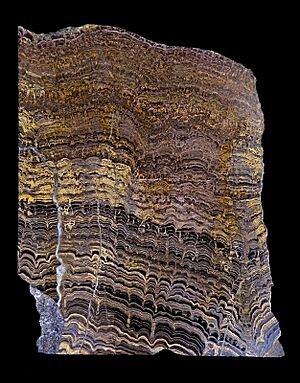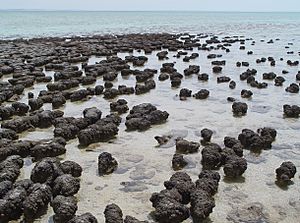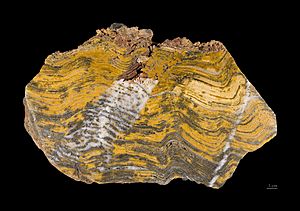Stromatolite facts for kids

Stromatolites are special, layered rock-like structures. They usually form in shallow water, often near coastlines. These amazing structures are built by tiny living things, mostly bacteria like cyanobacteria.
Contents
How Stromatolites Form
Stromatolites grow very slowly over long periods. Here's how they are made:
- Tiny bacteria, especially cyanobacteria, live in layers.
- These bacteria produce a sticky substance, like mucus.
- This sticky mucus traps tiny grains of sediment, such as sand or mud, from the water.
- The bacteria also help to produce calcium carbonate, which acts like a glue.
- Over time, these layers of trapped sediment and calcium carbonate build up. This creates the unique, layered shapes we see in stromatolites.
Cyanobacteria are special because they can use sunlight, water, and carbon dioxide to make their own food. This process is called photosynthesis. A very important part of their photosynthesis is that they release oxygen as a waste product.
Stromatolites: Earth's Oldest Life Signs
The most important thing about stromatolites is that they are the earliest fossil evidence of life on Earth. Scientists have found stromatolites that are about 3.45 billion years old! These ancient structures formed during the Archaean eon, a very early time in Earth's history.
How Stromatolites Changed Our Planet
The ability of cyanobacteria to perform photosynthesis and produce oxygen was incredibly important for our planet. Early cyanobacteria, living in stromatolites, are thought to be largely responsible for adding a lot of oxygen to Earth's early atmosphere. They were the first known living things to create free oxygen.
This process took a very long time, about a billion years. Eventually, this build-up of oxygen led to a huge change called the Great Oxygenation Event. This event changed the atmosphere so much that it was harmful to many organisms that couldn't live with oxygen. It also created the oxygen-rich environment we have today, which is necessary for most life forms, including humans.
Related pages
Images for kids
-
Stromatolites at Strelley Pool chert (Pilbara Craton) - Western Australia
-
Pre-Cambrian stromatolites in the Siyeh Formation, Glacier National Park
-
Stromatolites at Lake Thetis, Western Australia
-
Stromatolites at Highborne Cay, in the Exumas, The Bahamas
-
Microbialite towers at Pavilion Lake, British Columbia
-
'Crayback' stromatolite - Nettle Cave, Jenolan Caves, NSW, Australia
See also
 In Spanish: Estromatolito para niños
In Spanish: Estromatolito para niños











